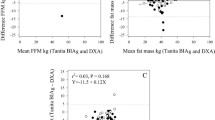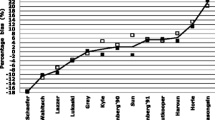Background
The primary aim of weight loss intervention in obesity is the loss of fat mass (FM). Hence, determinations of changes in FM and fat free mass (FFM) during weight loss are of clinical value. The authors compared the clinical utility of SkinFold Thickness (SKF), tetrapolar bioelectrical impedance analysis (BIA) and a body mass index (BMI) based calculation, in determining changes in percentage of fat mass (Δ%FM).
Methods
Using dual X-ray absorptiometry (DEXA) measurements of %FM as a standard, BIA, SKF and BMI were compared in 41 moderately obese women (BMI 30–35) before and after significant weight loss (−13.9 ± 5.8 kg).
Results
When measuring fat mass loss, SKF was precise and accurate with a bias of + 0.86 ± 6.16%, while the BMI-based estimation had a systematic bias of + 6.36 ± 6.04% (r2 = 0.791, P < 0.001). BIA using the Lukaski formula had a bias of + 5.22% and limits of agreement that approached the magnitude of the measurement (± 20.82%), thus providing no information. In contrast, BIA using the Segal formula had a systematic bias of + 7.81% (r2 = 0.636, P < 0.001) and gave narrower limits of agreement (± 8.34%).
Conclusion
For measuring changes in %FM with weight loss, BIA has no clinical value using the Lukaski formula, and using the Segal formula BIA provided no additional information to that given by BMI. We show that BIA instrument variables confound the estimates of %FM achieved by the BMI component of the Lukaski and Segal formulas.
Similar content being viewed by others
References
Hedley AA, Ogden CL, Johnson CL et al. Prevalence of overweight and obesity among US children, adolescents, and adults, 1999–2002. JAMA 2004; 291: 2847–50.
Campbell I. The obesity epidemic: can we turn the tide? Heart 2003; 89 (Suppl 2): ii22–24; discussion ii35–27.
Bellanger TM, Bray GA. Obesity related morbidity and mortality. J La State Med Soc 2005; 157 (Spec No 1): S42–S49; quiz 49.
Ellis KJ. Human body composition: in vivo methods. Physiol Rev 2000; 80: 649–80.
Durnin JV, Womersley J. Body fat assessed from total body density and its estimation from skinfold thickness: measurements on 481 men and women aged from 16 to 72 years. Br J Nutr 1974; 32: 77–97.
Lukaski HC, Bolonchuk WW, Hall CB et al. Validation of tetrapolar bioelectrical impedance method to assess human body composition. J Appl Physiol 1986; 60: 1327–32.
Cox-Reijven PL, van Kreel B, Soeters PB. Accuracy of bioelectrical impedance spectroscopy in measuring changes in body composition during severe weight loss. [comment]. JPEN 2002; 26: 120–7.
Haarbo J, Gotfredsen A, Hassager C et al. Validation of body composition by dual energy X-ray absorptiometry (DEXA). Clin Physiol 1991; 11: 331–41.
Salamone LM, Fuerst T, Visser M et al. Measurement of fat mass using DEXA: a validation study in elderly adults. J Appl Physiol 2000; 89: 345–52.
Pritchard JE, Nowson CA, Strauss BJ et al. Evaluation of dual energy X-ray absorptiometry as a method of measurement of body fat. Eur J Clin Nutr 1993; 47: 216–28.
Aloia JF, Vaswani A, Ma R et al. Comparative study of body composition by dual-energy x-ray absorptiometry. J Nucl Med 1995; 36: 1392–7.
Di Lorenzo N, Servidio M, Di Renzo L et al. Is digital image plethysmographic (DIP) acquisition a valid new tool for preoperative body composition assessment? A validation by dual-energy X-ray absorptiometry? Obes Surg 2006; 16: 560–6.
Gallagher D, Heymsfield SB, Heo M et al. Healthy percentage body fat ranges: an approach for developing guidelines based on body mass index. Am J Clin Nutr 2000; 72: 694–701.
Wattanapenpaiboon N, Lukito W, Strauss BJ et al. Agreement of skinfold measurement and bioelectrical impedance analysis (BIA) methods with dual energy X-ray absorptiometry (DEXA) in estimating total body fat in Anglo-Celtic Australians. Int J Obes 1998; 22: 854–60.
Jackson AS, Pollock ML, Ward A. Generalized equations for predicting body density of women. Med Sci Sports Exerc 1980; 12: 175–181.
Segal KR, Van Loan M, Fitzgerald PI et al. Lean body mass estimation by bioelectrical impedance analysis: a four-site cross-validation study. Am J Clin Nutr 1988; 47: 7–14.
Hendel HW, Gotfredsen A, Hojgaard L et al. Change in fat-free mass assessed by bioelectrical impedance, total body potassium and dual energy X-ray absorptiometry during prolonged weight loss. Scand J Clin Lab Invest 1996; 56: 671–9.
Bland JM, Altman DG. Statistical methods for assessing agreement between two methods of clinical measurement. [see comment]. Lancet 1986; 1: 307–10.
Abdel-Hamid TK. Exercise and diet in obesity treatment: an integrative system dynamics perspective. Med Sci Sports Exerc 2003; 35: 400–13.
Busetto L. Visceral obesity and the metabolic syndrome: effects of weight loss. Nutr Metab Cardiovasc Dis 2001; 11: 195–204.
Silva AM, Shen W, Wang Z et al. Three-compartment model: critical evaluation based on neutron activation analysis. Am J Physiol Endocrinol Metab 2004; 287: E962–E969.
Mazess RB, Barden HS, Bisek JP et al. Dual-energy x-ray absorptiometry for total-body and regional bone-mineral and soft-tissue composition. Am J Clin Nutr 1990; 51: 1106–12.
The IDF consensus worldwide definition of the metabolic syndrome. Brussels: International Diabetes federation, 2005.
Faloia E, Canibus P, Gatti C et al. Body composition, fat distribution and metabolic characteristics in lean and obese women with polycystic ovary syndrome. J Endocrinol Invest 2004; 27: 424–9.
Olds TS, Harten NR. One hundred years of growth: the evolution of height, mass, and body composition in Australian children, 1899–1999. Hum Biol 2001; 73: 727–38.
Gray DS, Bray GA, Bauer M et al. Skinfold thickness measurements in obese subjects. Am J Clin Nutr 1990; 51: 571–7.
Frisard MI, Greenway FL, Delany JP. Comparison of methods to assess body composition changes during a period of weight loss. Obes Res 2005; 13: 845–54.
Panotopoulos G, Ruiz JC, Guy-Grand B et al. Dual x-ray absorptiometry, bioelectrical impedance, and near infrared interactance in obese women. Med Sci Sports Exerc 2001; 33: 665–70.
Ellis KJ, Bell SJ, Chertow GM et al. Bioelectrical impedance methods in clinical research: a follow-up to the NIH Technology Assessment Conference. Nutrition 1999; 15: 874–80.
Kyle UG, Genton L, Karsegard L et al. Single prediction equation for bioelectrical impedance analysis in adults aged 20–94 years. Nutrition 2001; 17: 248–53.
Kyle UG, Genton L, Mentha G et al. Reliable bioelectrical impedance analysis estimate of fat-free mass in liver, lung, and heart transplant patients. JPEN 2001; 25: 45–51.
Houtkooper LB, Lohman TG, Going SB et al. Why bioelectrical impedance analysis should be used for estimating adiposity. Am J Clin Nutr 1996; 64 (Suppl 3): 436S–448S.
Das SK, Roberts SB, Kehayias JJ et al. Body composition assessment in extreme obesity and after massive weight loss induced by gastric bypass surgery. Am J Physiol Endocrinol Metab 2003; 284: E1080–1088.
Heymsfield S, Allison DB, Baumgartner RN et al. Evaluation of total and regional body composition. In: Bray GA, James WPT, eds. Handbook of Obesity. New York: Marcel Dekker, 1998: 41–77.
Webber J, Donaldson M, Allison SP et al. A comparison of skinfold thickness, body mass index, bioelectrical impedance analysis and dual energy X-ray absorptiometry in assessing body composition in obese subjects before and after weight loss. Clin Nutr 1994; 13: 177–82.
Frankenfield DC, Rowe WA, Cooney RN et al. Limits of body mass index to detect obesity and predict body composition. Nutrition 2001; 17: 26–30.
Author information
Authors and Affiliations
Corresponding author
Rights and permissions
About this article
Cite this article
Alvarez, V.P., Dixon, J.B., Strauss, B.J.G. et al. Single Frequency Bioelectrical Impedance is a Poor Method for Determining Fat Mass in Moderately Obese Women. OBES SURG 17, 211–221 (2007). https://doi.org/10.1007/s11695-007-9032-3
Received:
Accepted:
Published:
Issue Date:
DOI: https://doi.org/10.1007/s11695-007-9032-3




